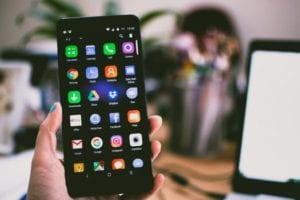Written by Angeline A. De Leon, Staff Writer. Mobile phone contamination with methicillin-sensitive Staphylococcus aureus (MRSA) and Gram-negative bacteria from the mobile phones of doctors treating high-risk patients calls for guidelines for mobile phone disinfection.
 Although preventable, healthcare-associated infections (HAIs), referring to infections that are contracted by patients while receiving medical treatment, are becoming increasingly common, with 10% of hospital patients in developing countries estimated to acquire at least one HAI 1. Due to the use of more invasive equipment (e.g., catheters) in intensive care units (ICUs), neonatal care units (NCUs), and pediatric care units (PCUs), and the poorer health status of their patient population, the prevalence of HAIs in these units are relatively higher 2. Studies estimate that the prevalence of mobile phone contamination among clinicians in developed countries is in the range of 75% to 96% 3. Among microorganisms traced from clinicians’ mobile phones are Escherichia coli and methicillin-sensitive Staphylococcus aureus (MRSA) 4. High rates of contamination have also been reported in the public hospitals of developing countries 5, but the prevalence of HAIs among the most vulnerable hospital patients, those in ICUs and NCUs, have largely been unstudied 6. Thus, in a study 6 published in BMC Infectious Diseases (2015), researchers sought to explore the prevalence of mobile phone contamination among clinicians working in ICUs, NCUs, and PICUs in Kuwait, as well as the factors associated with contamination.
Although preventable, healthcare-associated infections (HAIs), referring to infections that are contracted by patients while receiving medical treatment, are becoming increasingly common, with 10% of hospital patients in developing countries estimated to acquire at least one HAI 1. Due to the use of more invasive equipment (e.g., catheters) in intensive care units (ICUs), neonatal care units (NCUs), and pediatric care units (PCUs), and the poorer health status of their patient population, the prevalence of HAIs in these units are relatively higher 2. Studies estimate that the prevalence of mobile phone contamination among clinicians in developed countries is in the range of 75% to 96% 3. Among microorganisms traced from clinicians’ mobile phones are Escherichia coli and methicillin-sensitive Staphylococcus aureus (MRSA) 4. High rates of contamination have also been reported in the public hospitals of developing countries 5, but the prevalence of HAIs among the most vulnerable hospital patients, those in ICUs and NCUs, have largely been unstudied 6. Thus, in a study 6 published in BMC Infectious Diseases (2015), researchers sought to explore the prevalence of mobile phone contamination among clinicians working in ICUs, NCUs, and PICUs in Kuwait, as well as the factors associated with contamination.
A cross-sectional study was carried out with a group of 198 clinicians with mobile phones (some with more than one) working in the ICUs, PICUs, and NCUs of public secondary care hospitals in Kuwait. Clinicians completed a self-administered questionnaire assessing their use of mobile phones at work, the frequency of mobile phone disinfection, and the type of disinfectant used to clean mobile devices. Swab samples were taken from clinicians’ mobile phones for culture, and laboratory testing was carried out for microbiological identification and determination of bacterial growth patterns.
Of participating clinicians, only 33.5% (68/198) reported having ever disinfected their mobile phones. Of that subgroup, about half (32/68) reported disinfecting their phones daily or weekly, and 41.1% (28) reported disinfecting their phones only when dirty. 73.5% of clinicians who reported cleaning their mobile phones used alcohol wipes and 13.2% used liquid hand disinfectant. Laboratory testing revealed that of 213 mobile phones, 157 (73.7%, 95% Confidence Interval: 67.2 to 79.5%) were contaminated. The most common organisms isolated from mobile phones were coagulase-negative staphylococci (CoNS) (62.9% of phones contaminated) and Micrococcus (28.6% of phones contaminated). The only factor significantly associated with mobile phone contamination was whether clinicians had ever disinfected their phones (adjusted odds ratio = 2.42, 95% CI: 1.08 to 5.41, p = 0.031).
General findings indicate that the prevalence of mobile phone contamination among clinicians in ICUs, NCUs, and PICUs is high. Although most phones were colonized by non-pathogenic bacteria (CoNS and Micrococcus), their presence among patients with compromised immune systems still presents a potential health risk 4. Given that only a minority of clinicians reported having ever disinfected their phones, the present study highlights the need to increase awareness about the importance of mobile phone hygiene practices in healthcare settings. Additional studies would be valuable in helping to establish the association between microbiological contamination rates of clinicians’ mobile phones and the actual prevalence of HAI occurrence among patients in their wards.
Source: Heyba M, Ismaiel M, Alotaibi A, et al. Microbiological contamination of mobile phones of clinicians in intensive care units and neonatal care units in public hospitals in Kuwait. BMC Infectious Diseases. 2015; 15: 434. DOI: 10.1186/s12879-015-1172-9.
© 2015 Heyba et al. Open Access This article is distributed under the terms of the Creative Commons Attribution 4.0 International License (http://creativecommons.org/licenses/by/4.0/), (http://creativecommons.org/publicdomain/zero/1.0/)
Click here to read the full text study.
Posted July 22, 2019.
References:
- Organization WH. Report on the burden of endemic health care-associated infection worldwide. 2011.
- Newby J. Nosocomial infection in neonates: inevitable or preventable? The Journal of perinatal & neonatal nursing. 2008;22(3):221-227.
- Brady RR, Verran J, Damani N, Gibb A. Review of mobile communication devices as potential reservoirs of nosocomial pathogens. Journal of Hospital Infection. 2009;71(4):295-300.
- Ustun C, Cihangiroglu M. Health care workers’ mobile phones: a potential cause of microbial cross-contamination between hospitals and community. Journal of occupational and environmental hygiene. 2012;9(9):538-542.
- Sadat-Ali M, Al-Omran AK, Azam Q, et al. Bacterial flora on cell phones of health care providers in a teaching institution. American journal of infection control. 2010;38(5):404-405.
- Heyba M, Ismaiel M, Alotaibi A, et al. Microbiological contamination of mobile phones of clinicians in intensive care units and neonatal care units in public hospitals in Kuwait. BMC infectious diseases. 2015;15(1):434.

